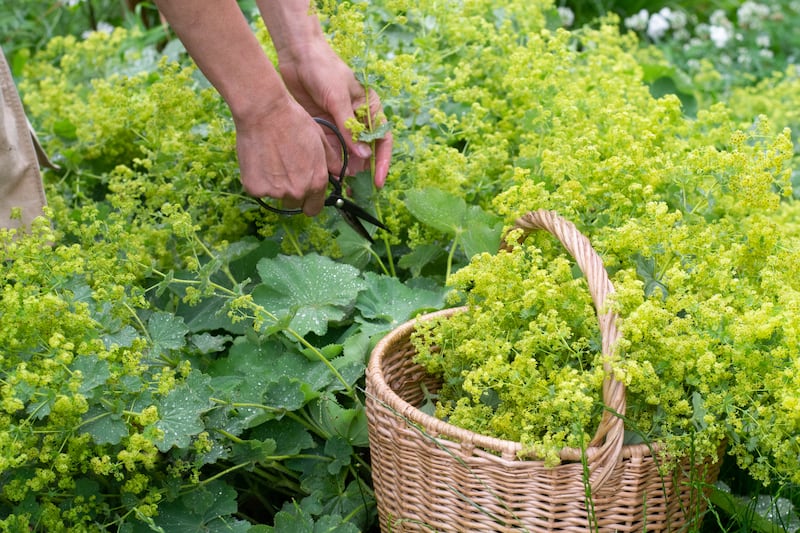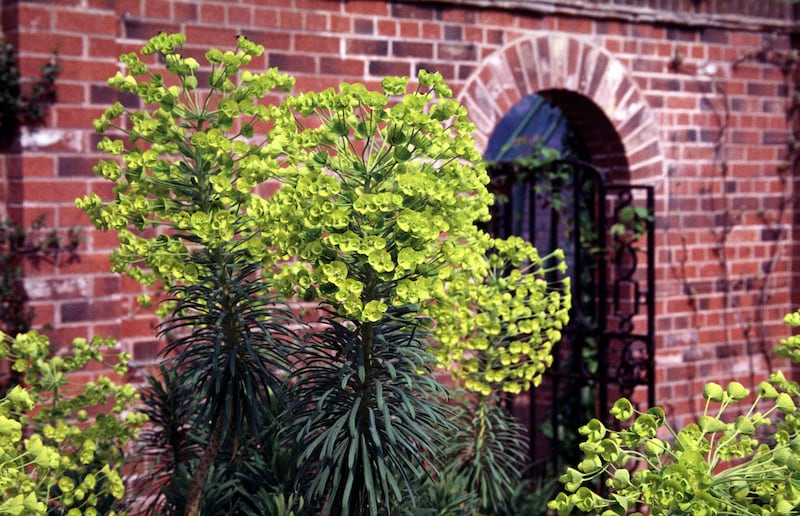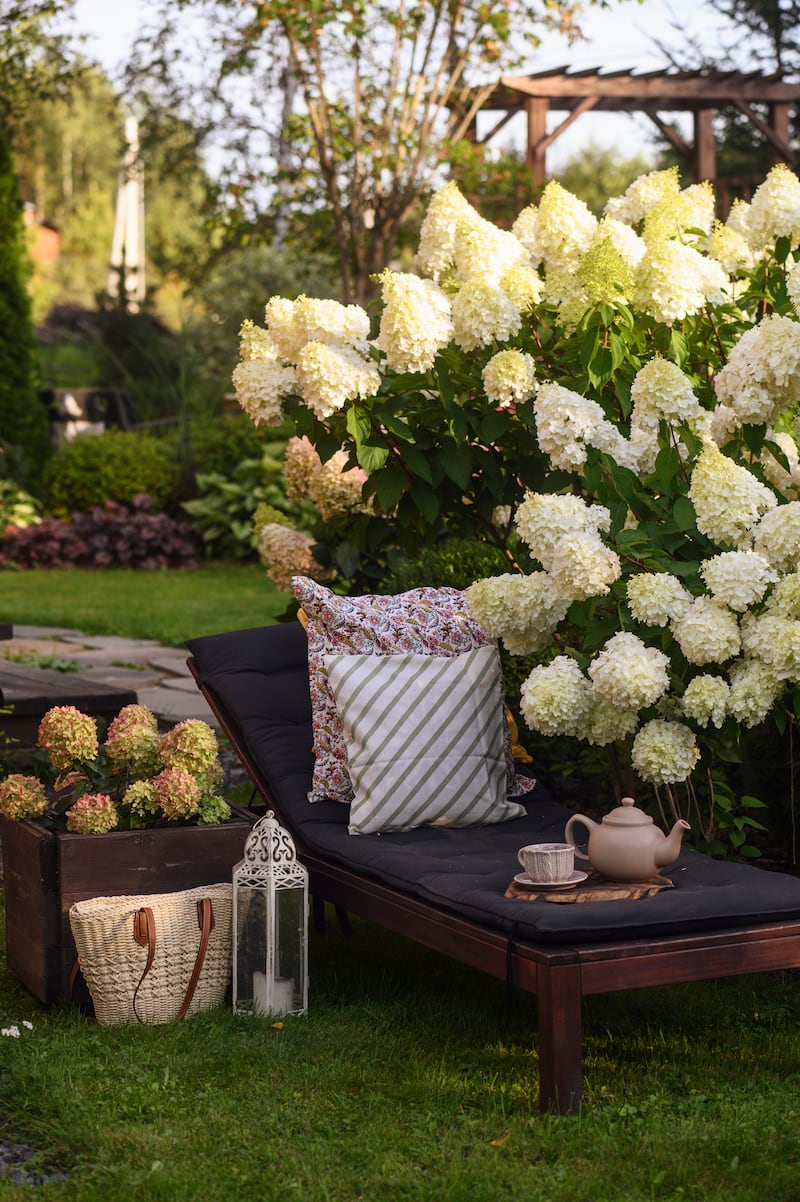Colour – especially the use of colour in the garden – is a famously subjective thing. For example, hot pink, bright yellow, deep burgundy, or fiery orange will always be anathema for some, while for others they’re supremely joyful and uplifting. However when it comes to shades of green, I think we’re all in agreement.
Green flowering plants in particular have an unerring ability to be the all-important glue in any planting scheme. Just think of the lime-green blooms of lady’s mantle, or Alchemilla mollis as it’s properly known, which never puts a foot wrong colour-wise (admittedly the same can’t always be said for its propensity to self-seed). Its fluffy, long-lasting flower panicles first appear in early June and look as good combined with the violet umbels of alliums, or with shocking pink roses, as they do with acid-orange geums, or bright yellow trollius, the reason why flower arrangers adore them so much.

That same quality of supreme versatility is true of trusty Euphorbia characias ssp. wulfenii, whose stately, pistachio-green flower bracts effortlessly co-ordinate with pretty much everything else in the garden, no matter how gaudy its neighbours. In bloom from mid-spring until late summer, the celebrated British garden designer Gertrude Jekyll once described it, with good reason, as “the grandest of plants”, but it’s also a trooper with the power to tolerate the hottest and driest of soils. Other garden-worthy, green-flowering. floriferous species of euphorbia to consider include the lovely summer-blooming Euphorbia palustris, a hardy herbaceous perennial; and the compact, exceptionally long flowering, evergreen Euphorbia martinii.


Hydrangea paniculata ‘Limelight’ is another brilliant garden mingler, with large panicles of flowers that first emerge in July in the most charming shade of apple-green before gradually fading to cream with soft hints of pale pink as the season progresses. This hardy deciduous shrub does especially well in our mild, damp climate, relishing a rich, moisture-retentive soil that never totally dries out. A staple of the late summer garden, it provides the perfect foil for the zingy blooms of late-flowering perennials such as dahlia, crocosmia, helenium, echinacea, hemerocallis and alstroemeria. For growing in a large tub or container, seek out Hydrangea ‘Polar Bear’, a very similar but more compact close relative. Just make sure to keep it regularly watered, as drought-resistance is most definitely not its thing.
READ MORE

For a sheltered spot, ideally trained against a wall, nothing compares with Itea ilicifolia or Virginian willow as it’s commonly known, a plant I first saw in Helen Dillon’s Ranelagh garden many years ago. A glorious specimen, she’d propagated it from a cutting taken from a mature plant growing in a neighbouring garden. The latter was very probably planted by the property’s illustrious former owner, the famous Irish plant hunter Augustine Henry, who also first introduced Itea ilicifolia into cultivation. Somewhat reminiscent of amaranthus but more refined, this large evergreen shrub’s jade-green, intensely-scented, tassel-shaped flowers appear in abundance on the plant in late summer and are a show-stopping sight.
Speaking of which, Amaranthus caudatus var. viridis, or love-lies-bleeding as it’s commonly known, is another wonderful green-flowering plant for the summer cut-flower patch. Long, dangling, chenille-like flower tassels appear on this half-hardy annual from July onwards, gradually thickening and lengthening as autumn approaches. Those eye-catching, supremely tactile flower tassels (their large leaves carefully picked off) make a wonderfully sculptural addition to an arrangement or bouquet, one of the reasons why it’s become one of the most fashionable of bridal flowers in recent years. In my own little flower farm, I grow it in abundance from seed sown under cover each spring.
Another personal favourite is Nicotiana langsdorfii, a supremely graceful member of the tobacco family with tall, slender flower stems adorned with tiny, dangling green bells. A brilliant cut-flower, this half-hardy, summer-flowering annual will often politely self-seed around the place when it’s happy, while the ripe seed can also be easily home-saved in late summer for sowing under cover the following spring.
For something more long-lived, look to Tellima grandiflora, or fringe cups as it’s commonly known. Tough as old boots, I grow this hardy semi-evergreen perennial in a dry, north-facing bed where few things will flourish. In late spring its tall, long-lasting, very slender stems of chartreuse-green, miniature bell-shaped flowers emerge, slowly unfurling like ferns. A generous self-seeder in rich, moist soils, it combines beautifully with other spring flowering perennials and bulbous plants including aquilegia, forget-me-nots, tulips and lunaria.

Other garden-worthy members of this invaluable green-flowering club include the spring-flowering, shade-tolerant, evergreen perennial known as Helleborus argutifolius or the Corsican hellebore; the spring-flowering, shade-tolerant, herbaceous perennial known as Helleborus x nigercors ‘The Rockies Pike Peak’; the large deciduous shrub known as Viburnum opulus ‘Roseum’ or the snowball tree, whose clusters of pompon-shaped flowers emerge lime-green in late spring before gradually fading to a creamy white; and the shade-tolerant, summer-flowering hardy perennial known as Heuchera ‘Goldfinch’.
Add just a few of these to your garden and you’ll be regularly reminded of the power of green to calm, soothe and enliven even the tiniest of growing spaces like no other.
This week in the garden
To guarantee the widest choice of varieties, start ordering spring flowering bulbs now from online suppliers for delivery later this year. Recommended suppliers include Dublin-based mrmiddleton.com, which celebrates its 50th anniversary this year, Cork-based fruithillfarm.com (small selection of organically produced bulbs) and UK-based peternysssen.com.
Vine weevil is a common pest in many Irish gardens, especially of container-grown plants or those growing in raised beds where a peat-based compost has been used. This month is a great time to apply a nematode-control (Steinernema) as a soil drench, an organically acceptable way of disrupting this pest’s life cycle by killing off its destructive white larvae, which live in the ground and feed on plant roots. It also kills the larvae of carrot fly and cabbage root fly. Stockists include all good garden centres.
Dates for your diary
ISNA Plant Fair Loughcrew Gardens, Oldcastle, Co Meath; Sunday, August 17th. With stalls by many of the country’s leading independent small specialist nurseries. loughcrewestate.com
Blight & Bounty’: Glasnevin in the Famine Years National Botanic Gardens, Glasnevin, Dublin 9; Saturday, August 23rd and Wednesday. August 27th. Guided tour taking in exotic imports, orchid innovations, symphonies in iron and glass and the discovery of potato blight. Pre-booking through eventbrite.ie essential, tickets €5.
Irish National Vegetable Championships The Showgrounds, Moate, Co Westmeath; Sunday, August 24th (10am-5pm). The annual competition takes place as part of the Moate Agricultural Show and includes a new junior category. See nvsuk.org.uk for schedule and downloadable entry form.


















